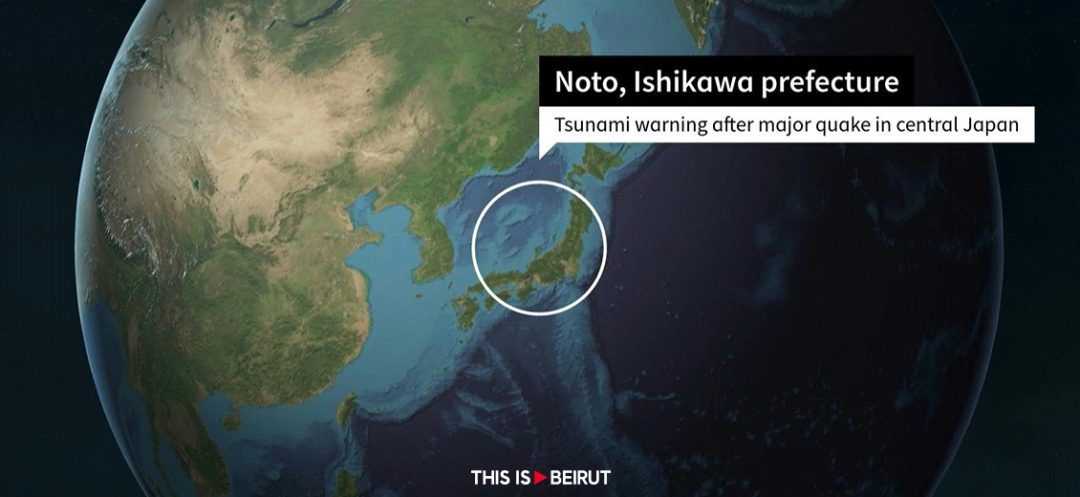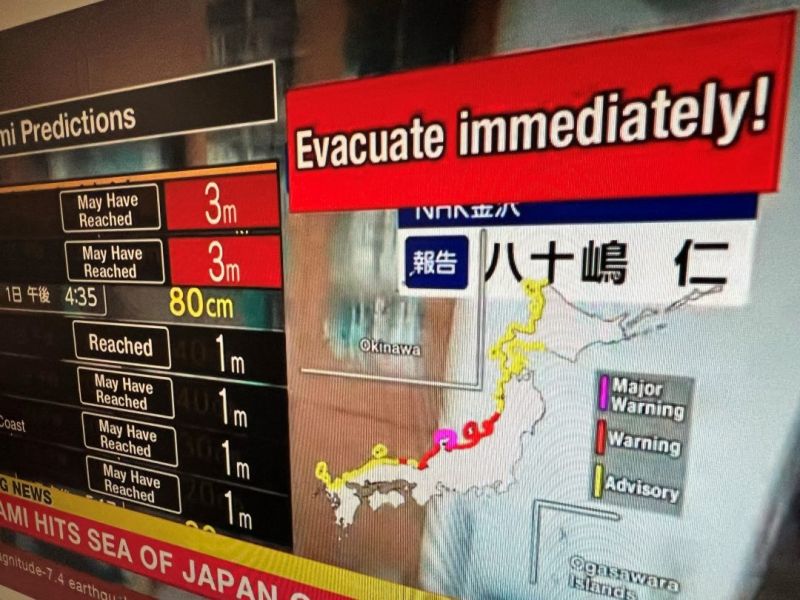- Home
- Middle East
- Emergency Evacuations as Japan Faces Quake and Tsunami

©(AFP)
Central Japan experienced a series of powerful earthquakes, resulting in tsunami waves reaching over a meter high, prompting widespread evacuations, and reminiscent of the country's traumatic 2011 earthquake and tsunami disaster.
The tsunami threat from a powerful earthquake that struck central Japan on Monday has “largely passed,” a US agency said, after waves over a meter high had earlier hit some areas.
“The tsunami threat has now largely passed,” stated the Hawaii-based Pacific Tsunami Warning Center.
“Immediate evacuation to higher ground is advised for all residents,” declared national broadcaster NHK after the earthquakes.
The Pacific Tsunami Warning Center, based in Hawaii, cautioned of hazardous tsunami waves within 300 kilometers (190 miles) of the quake's epicenter along the Sea of Japan coast on Japan's main island of Honshu.
The Japanese government is currently assessing the extent of the damage and investigating the possibility of casualties. Approximately 33,500 households around the epicenter, in Toyama, Ishikawa, and Niigata prefectures, are without power, according to local utilities.
A poignant video shared on the social media platform X depicted rows of wooden houses toppled by the earthquakes, with walls and roofs collapsed.
Due to potential tsunami risks after the Japanese earthquakes, Sakhalin Island and Vladivostok in Russia's far east are on “alert,” according to officials.
 A NHK World warning urging evacuation in Hong Kong due to major earthquakes in central Japan, January 1, 2024. (Mladen Antonov, AFP)
A NHK World warning urging evacuation in Hong Kong due to major earthquakes in central Japan, January 1, 2024. (Mladen Antonov, AFP)
Significant transportation disruptions are reported, with major highways closed around the epicenter, and Shinkansen bullet train services suspended between Tokyo and Noto.
Government spokesman Yoshimasa Hayashi assured that no abnormalities were reported at the Shika nuclear power plant in Ishikawa or at other plants.
Despite Japan's stringent construction regulations designed to withstand earthquakes and routine emergency drills, the nation is haunted by the memory of the massive 9.0-magnitude undersea quake off northeastern Japan in March 2011. This event triggered a tsunami that claimed the lives of around 18,500 people and sent three reactors into meltdown at the Fukushima nuclear plant, marking Japan's worst post-war disaster and the most serious nuclear accident since Chernobyl.
The tsunami threat from a powerful earthquake that struck central Japan on Monday has “largely passed,” a US agency said, after waves over a meter high had earlier hit some areas.
“The tsunami threat has now largely passed,” stated the Hawaii-based Pacific Tsunami Warning Center.
“Immediate evacuation to higher ground is advised for all residents,” declared national broadcaster NHK after the earthquakes.
The Pacific Tsunami Warning Center, based in Hawaii, cautioned of hazardous tsunami waves within 300 kilometers (190 miles) of the quake's epicenter along the Sea of Japan coast on Japan's main island of Honshu.
The Japanese government is currently assessing the extent of the damage and investigating the possibility of casualties. Approximately 33,500 households around the epicenter, in Toyama, Ishikawa, and Niigata prefectures, are without power, according to local utilities.
A poignant video shared on the social media platform X depicted rows of wooden houses toppled by the earthquakes, with walls and roofs collapsed.
Due to potential tsunami risks after the Japanese earthquakes, Sakhalin Island and Vladivostok in Russia's far east are on “alert,” according to officials.
 A NHK World warning urging evacuation in Hong Kong due to major earthquakes in central Japan, January 1, 2024. (Mladen Antonov, AFP)
A NHK World warning urging evacuation in Hong Kong due to major earthquakes in central Japan, January 1, 2024. (Mladen Antonov, AFP)Significant transportation disruptions are reported, with major highways closed around the epicenter, and Shinkansen bullet train services suspended between Tokyo and Noto.
Government spokesman Yoshimasa Hayashi assured that no abnormalities were reported at the Shika nuclear power plant in Ishikawa or at other plants.
Despite Japan's stringent construction regulations designed to withstand earthquakes and routine emergency drills, the nation is haunted by the memory of the massive 9.0-magnitude undersea quake off northeastern Japan in March 2011. This event triggered a tsunami that claimed the lives of around 18,500 people and sent three reactors into meltdown at the Fukushima nuclear plant, marking Japan's worst post-war disaster and the most serious nuclear accident since Chernobyl.
Miroslava Salazar, with AFP
Read more




Comments